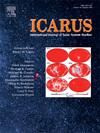Radiation sputtering of hydrocarbon ices at Europa-relevant temperatures
IF 2.5
2区 物理与天体物理
Q2 ASTRONOMY & ASTROPHYSICS
引用次数: 0
Abstract
The surfaces of some icy moons, such as Jupiter's moon Europa, are heavily bombarded by energetic particles that can alter the surface materials and affect the composition of its exosphere. Detection of CO2 on Europa's surface indicate that Europa's interior may be transporting freshly exposed carbon-containing material to the surface. It is unknown whether this CO2 is a product of radiation of carbon-containing precursors or whether it is present in the initial deposits. Regardless, further radiolysis by high-energy electrons or ions can sputter CO2 (and organic fragments if present) into Europa's exosphere. In this study, we investigate the radiation sputtering of CO2 and organic fragments from hydrocarbon water ice mixtures at different Europa-relevant surface temperatures to identify how its sputtering products evolve over time. This study shows that the sputtering of hydrocarbon water ice leads to the production of mostly CO2, CO, and fragmented hydrocarbons. The onset of sputtered hydrocarbons is immediate, and quickly reaches a steady state, whereas CO2 and CO are formed more gradually. It is found that higher temperatures cause more sputtering, and that there are some notable differences in the distribution of species that are sputtered at different temperatures, indicating local heterogeneity of sputtering yields depending on the surface temperature.
在木卫二相关温度下碳氢化合物冰的辐射溅射
一些冰冷卫星的表面,如木星的卫星木卫二,受到高能粒子的猛烈轰击,这些高能粒子可以改变表面物质并影响其外逸层的组成。探测到木卫二表面的二氧化碳表明木卫二内部可能正在将新暴露的含碳物质运送到表面。目前尚不清楚这些二氧化碳是含碳前体辐射的产物,还是存在于最初的沉积物中。无论如何,高能电子或离子的进一步辐射分解会将二氧化碳(如果存在的话还有有机碎片)溅射到木卫二的外逸层中。在这项研究中,我们研究了碳氢化合物水冰混合物中CO2和有机碎片在不同木卫二相关表面温度下的辐射溅射,以确定其溅射产物如何随时间演变。这项研究表明,碳氢化合物水冰的溅射导致了大部分二氧化碳、一氧化碳和碎片化碳氢化合物的产生。溅射的碳氢化合物是立即开始的,并迅速达到稳定状态,而二氧化碳和一氧化碳则是逐渐形成的。研究发现,温度越高,溅射率越高,在不同温度下溅射的物质分布存在显著差异,表明溅射产量随表面温度的局部不均匀性。
本文章由计算机程序翻译,如有差异,请以英文原文为准。
求助全文
约1分钟内获得全文
求助全文
来源期刊

Icarus
地学天文-天文与天体物理
CiteScore
6.30
自引率
18.80%
发文量
356
审稿时长
2-4 weeks
期刊介绍:
Icarus is devoted to the publication of original contributions in the field of Solar System studies. Manuscripts reporting the results of new research - observational, experimental, or theoretical - concerning the astronomy, geology, meteorology, physics, chemistry, biology, and other scientific aspects of our Solar System or extrasolar systems are welcome. The journal generally does not publish papers devoted exclusively to the Sun, the Earth, celestial mechanics, meteoritics, or astrophysics. Icarus does not publish papers that provide "improved" versions of Bode''s law, or other numerical relations, without a sound physical basis. Icarus does not publish meeting announcements or general notices. Reviews, historical papers, and manuscripts describing spacecraft instrumentation may be considered, but only with prior approval of the editor. An entire issue of the journal is occasionally devoted to a single subject, usually arising from a conference on the same topic. The language of publication is English. American or British usage is accepted, but not a mixture of these.
 求助内容:
求助内容: 应助结果提醒方式:
应助结果提醒方式:


